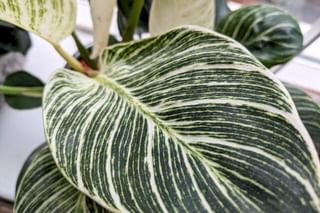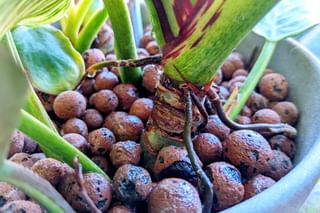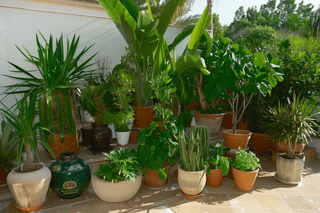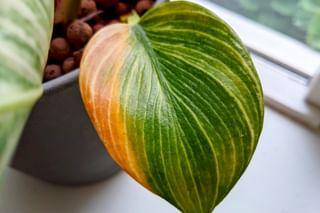How to care for a Philodendron Birkin
The Philodendron Birkin is a beautiful plant with striking white stripes on its green leaves. It shows you when it's not happy, which makes it the perfect plant for beginners. In this guide, we're going to look at how you can take care of this beautiful, yet easy-going house plant.

The Philodendron Birkin is a beautiful plant with striking white stripes on its green leaves. These patterns might make you think that the Philodendron Birkin is a difficult plant to take care of, but luckily that's not true. The Philodendron Birkin shows you when it's not happy, which makes it the perfect plant for beginners. In this guide, we're going to look at how you can take care of this beautiful, yet easy-going house plant.
We're going to look at these topics related to Philodendron plant care:
Let's get right into the tips on how to take care of this wonderful house plant.
How do I water my Philodendron Birkin?
Watering your Philodendron Birkin is one of the easiest things to get right. Watering can be quite tough for some plants, but you'll have to find the right balance. The Philodendron Birkin is usually not a very thirsty plant, so you can let them be for a few weeks before watering them.
If you're looking for a watering schedule to use for this plant, it's this: Water this plant once every 2-3 weeks. Before watering your plant, make sure to check the soil. The top of the soil should be dry before you water your plant.
If you water this plant a little too much, it won't kill the plant right away, but it will likely show you it's not happy by dropping a few leaves. These leaves will turn mushy and brown.
How much sunlight does a Philodendron Birkin need?
The Philodendron Birkin is the perfect house plant when it comes to light requirements. It doesn't want to be in a low-light place, but also not in direct sunlight. However, you can put it in any other type of light exposure. This makes it great for windowsills that don't get any direct sunlight or just any other place away from windows in sunny rooms.
This plant doesn't like low-light situations. When it doesn't get enough sunlight, two things will happen. The first thing you'll notice is that the plant starts to grow towards a light source. The second thing is that the bright white lines on its leaves will start to fade to dark green.
When the Philodendron Birkin is exposed to direct sunlight, it will get sunburned quite easily. Once you see sunburns, move your plant to a place where it doesn't get any direct sunlight.
How much humidity does a Philodendron Birkin need?
The Philodendron Birkin is a tropical plant and loves humidity. This is part of the reason it loves to sit in moist soil most of the time. To help your plant be happy, make sure to keep it in a humid place. You can do this by misting it occasionally, but also by keeping it around other plants. These plants will keep their environment more humid and grouping plants helps a lot. If you're looking for more ideas to raise the humidity for your plant, read "10 ways to raise the humidity in your house".
Are there any specific temperature requirements for a Philodendron Birkin?
Philodendron Birkin plants are a bit picky when it comes to temperature for their best growth and health. They love it when it's between 18 and 29 degrees Celsius (65 to 85 F). Make sure not to let them get chilly with temperatures falling below 18 Celsius (below 55 F) because they really can't stand the cold. These tropical plants thrive in warm and humid conditions, so keeping them within that temperature range will keep your Philodendron Birkin comfortable.
What is the best soil for a Philodendron Birkin?

As we've discovered in the earlier section about watering your Philodendron Birkin, this plant likes to grow in soil that dries out before it needs water again. We've also discussed that you should water this plant once every 2-3 weeks. So what does this have to do with the soil? Well, it means that you should find soil that drains well and dries out after a few days.
When we keep all of these things in mind, the perfect soil for your Philodendron Birkin is a mixture of these ingredients:
- General potting soil
- Perlite for excellent drainage
- Sphagnum moss to keep the soil light
The perlite helps to make the soil drain excess water quickly. This is important to prevent root rot. The perlite also helps the soil to dry out quickly, because your plant loves this.
To retain some moisture, but more importantly, to keep the soil nice and airy, we can add sphagnum moss to the soil. Sphagnum moss is a great way to maintain the structure of the soil without becoming too dense.
How often should I fertilize my Philodendron Birkin?
The Philodendron Birkin is quite a fast-growing house plant. Because it grows quickly that also means that it uses a lot of energy to grow new leaves. If you like that this plant grows quickly and you want it to keep doing this, you'll need to fertilize it regularly.
During the growing season, spring and summer, you should fertilize your Philodendron once per month. This will give your house plant the energy it needs to keep growing quickly. There are several ways to fertilize your house plant. You can use sticks, balls, or liquid fertilizer to feed your plant. Liquid fertilizer is one of the easiest ways to feed this plant since it likes to be watered once per week. You can simply add some fertilizer to the water once per month and that's how you can feed your plant.
During its dormant season, fall and winter, you should stop fertilizing. The dormant season means your plant will stop growing and use its energy to maintain the growth that's already there. Too much fertilizer in winter can cause salt build-up in the soil, which could kill your Philodendron. So it's best to stop fertilization until the spring.
Do Philodendron Birkin plants need any special pruning or grooming?
Philodendron Birkin plants don't need a lot of pruning, but grooming can help maintain their appearance and promote healthy growth. Here are some simple pruning and grooming tips:
- Remove dead or yellowing leaves: Make sure to give your Philodendron Birkin a check-up now and then. Did you spot any leaves that look dead or are turning yellow? Just snip them off right at the base with some clean, sharp scissors.
- Trim leggy stems: If your Birkin begins to look leggy or stretched out, you can prune back the stems to encourage bushier growth. Make cuts just above a leaf node (the point where a leaf or branch emerges from the stem).
- Shape the plant: You can prune your Philodendron Birkin lightly to shape it as desired. However, it's generally best to keep pruning minimal to avoid stressing the plant.
- Clean the leaves: Dust can accumulate on the large leaves, blocking light and giving pests an excuse to attack your plants. Gently wipe the leaves with a damp cloth or sponge to keep them clean and healthy.
The best time for pruning is in spring or summer, during the plant's active growing season. Always use clean tools to prevent the spread of disease. Regular grooming not only keeps your Philodendron Birkin looking its best but also keeps it healthy and promotes new growth.
How do I propagate my Philodendron Birkin?
Propagating a Philodendron Birkin can be a rewarding way to create new plants from your existing ones. Here's a simple guide on how to do it through stem cuttings, one of the most common and effective methods.
What you'll need:
- A healthy Philodendron Birkin plant
- Clean, sharp scissors or pruning shears
- A pot with drainage holes
- Potting mix suitable for Philodendrons
Steps to propagate
- Choose a stem: Look for a healthy stem on your Philodendron Birkin that has at least 2 to 3 leaves and a visible node. The node is a small bump or blemish on the stem from which roots will grow.
- Cut the stem: Using your clean, sharp scissors or pruning shears, cut just below a node. The cutting should be about 4 to 6 inches long.
- Prepare the cutting: Remove any leaves that are close to the cut end of the stem to prevent them from rotting when planted.
- Potting the cutting: Fill your pot with a well-draining potting mix. Make a small hole in the center of the soil with your finger or a pencil, and insert the cut end of your Philodendron Birkin cutting. Gently firm the soil around the stem to support it.
- Water and cover: Water the potting mix lightly, making sure it is moist but not waterlogged. To create a humid environment good for root growth, you can cover the pot with a clear plastic bag, making sure the bag does not touch the leaves by supporting it with sticks if necessary.
- Place in indirect light: Position the pot in a warm location with bright, indirect sunlight. Avoid direct sun exposure as it can scorch the leaves.
- Wait for roots to grow: Check the soil moisture regularly, keeping it lightly moist. In about 3-4 weeks, roots should begin to grow. You can gently tug on the cutting to feel for resistance, indicating root growth.
- Transplant if necessary: Once the roots are well established, you can transplant your new Philodendron Birkin into a larger pot if you want, following the same care requirements as the parent plant.
Patience is key when propagating plants. It might take a few weeks before you see significant root growth, but with proper care, your Philodendron Birkin cutting will develop into a healthy, new plant.
When should I repot my Philodendron Birkin?
We found out that the Philodendron Birkin is a fast-growing plant, which means it also needs to be repotted eventually. You don't have to repot this plant very often, like some plants, but you can't keep it in the same pot for 2 years when it's still young.
Usually, the Birkin outgrows its pot in a single growing season. This means you should repot your Philodendron Birkin once per year. It's best to repot in the early spring or summer when the plant is most active in growth.
After 2-3 years, your plant won't need to be repotted as much anymore, usually about once every 2-3 years.
When you're ready to repot your Philodendron Birkin, pick a pot that's about 1-2 inches (2.5-5 cm) bigger than the current pot. This way your Birkin has plenty of space to grow, but it's also not too big for your plant. You risk overwatering your house plants when you plant them in a pot that's too big. There will be too much moisture in the pot that your plant can't absorb quickly enough. When you repot your plant in an incrementally bigger pot, you don't risk overwatering your plant.
How do I repot my Philodendron Birkin?
Repotting can feel a bit scary if you're not used to it, but with the right tools and a little know-how, it's pretty easy and super satisfying. Let's walk you through how to repot your Philodendron Birkin so it can shine in its new home:
- Choose a new pot: Select a pot that is 1-2 inches larger in diameter than the current one, with good drainage holes.
- Prepare the pot: Fill the bottom with a fresh, well-draining potting mix formulated for tropical plants.
- Remove the plant: Gently remove the Philodendron Birkin from its current pot, being careful not to damage the roots.
- Position the plant: Place the plant in the center of the new pot and fill around it with more potting mix, leaving about an inch of space below the rim.
- Water thoroughly: Water the plant until water flows from the bottom of the pot, then let any excess moisture drain from the pot.
Can Philodendron Birkin plants be grown outdoors, or are they strictly indoor plants?
Philodendron Birkin plants can thrive outdoors under the right conditions, but they're mostly happy as indoor plants. They're a bit picky about temperature and light. Thinking about taking your Philodendron Birkin outside? Here's what you should think about:
The right climate
Philodendron Birkins are tropical plants that thrive in warm, humid environments. They can be grown outdoors year-round in USDA Hardiness Zones 10 to 12. In these regions, temperatures rarely drop below -1 degrees Celsius (30 F), which is suitable for outdoor growth.
Temperature, light, humidity
- Temperature: They prefer temperatures between 18 and 29 degrees Celsius (65 to 85 F). If your outdoor environment drops below 13 Celcius (55 F), it's best to keep your Philodendron Birkin indoors.
- Light: While they need bright, indirect light, direct sunlight can scorch their leaves. If growing outdoors, choose a spot that gets filtered light or partial shade, especially avoiding the harsh midday sun.
- Humidity: High humidity levels are pretty much perfect. Being outdoors naturally offers more humidity than being inside, especially if you're in a tropical or subtropical climate.
Transitioning Outdoors
If you decide to move your Philodendron Birkin outdoors, do so gradually to acclimate it to the new conditions and avoid shock. Start by placing it outside in a shaded, protected area for a few hours each day, slowly increasing its time outdoors over a week or two.
Make sure your outdoor Birkins stay safe from weather like pouring rain, strong winds, and direct sunlight. Moving them around with a pot can help keep them away from bad weather vibes.
Is the Philodendron Birking toxic for pets?
Unfortunately, the Philodendron Birkin, like many other tropical plants is toxic to both pets and humans. Because of this, make sure you keep it out of range of your cats and dogs, but also small children. This plant is only toxic when the leaves and stems have been chewed on. So if you notice that your pets have eaten this plant, make sure to call your vet right away for advice.
The leaves and stems contain calcium oxalate crystals, which cause irritation and stomach problems.
What are common pests or diseases that affect Philodendron Birkin and how can I treat them?

Philodendron Birkin plants are relatively resilient but can be vulnerable to certain pests and diseases. Here are some common issues and how to treat them:
Common pests
- Spider mites: These tiny pests can be identified by the fine, silky webs they leave on the plant. Treat by washing the leaves with water and applying neem oil or an insecticidal soap.
- Mealybugs: Look for white, cottony masses on the stems or undersides of leaves. Wipe them off with a cotton swab dipped in rubbing alcohol and apply neem oil as a preventative measure.
- Aphids: Small, green, or black insects that suck sap from the plant, weakening it. Rinse the plant with a strong stream of water or use insecticidal soap.
Common diseases
- Root rot: Often caused by overwatering, this condition leads to brown, mushy roots and wilted leaves. To treat, trim off the affected roots and repot the plant in fresh, well-draining soil. Make sure to use proper watering practices going forward.
- Leaf spot: Fungal or bacterial infections can cause dark spots on the leaves. Improve air circulation, reduce leaf wetness, and remove affected leaves. Fungicide or bactericide treatments can also be applied as needed.
General Prevention Tips
- Ensure good air circulation around your plant
- Use well-draining soil and pots with drainage holes to prevent waterlogging.
- Avoid overhead watering to keep leaves dry and reduce the risk of fungal diseases.
- Inspect your plant regularly for signs of pests or disease to catch issues early.
- Quarantine new plants before introducing them to your collection to prevent the spread of pests or diseases.
Quick action and regular care can keep those pests and diseases at bay, making sure your Philodendron Birkin stays looking healthy and vibrant.
Signs of problems on Philodendron Birkin
Philodendron Birkin plants will show several signs when they're unhappy or unhealthy. Recognizing these signs early can help you take quick action to restore your plant's health. Here are common symptoms and how to address them:
Yellowing leaves
- Cause: Overwatering, poor drainage, or nutrient deficiency.
- Solution: Make sure the pot has good drainage and the soil is not waterlogged. Allow the top few inches of soil to dry out between waterings. Consider repotting if the problem persists, and apply a balanced, liquid fertilizer every 4-6 weeks during the growing season.
Brown leaf tips or edges
- Cause: Underwatering, low humidity, or salt buildup from tap water.
- Solution: Increase watering frequency slightly, making sure the soil stays moist but not soggy. Use distilled or rainwater if possible. Mist the leaves regularly or use a humidifier to increase humidity.
Drooping leaves
- Cause: Both overwatering and underwatering can lead to drooping leaves.
- Solution: Check the soil moisture to determine the issue. If overwatered, allow the soil to dry out more between waterings. If underwatered, increase your watering frequency.
Leggy growth or small leaves
- Cause: Too little light.
- Solution: Move your Philodendron Birkin to a location where it receives bright, indirect sunlight. Avoid direct sun, which can scorch the leaves.
Pests infestation
- Signs: Stunted growth, sticky residue on leaves, or visible pests.
- Solution: Isolate the affected plant to prevent spreading. Wipe off pests with a damp cloth or use insecticidal soap, neem oil, or a suitable pesticide following product instructions.
Curling leaves
- Cause: Too much direct sunlight, low humidity, or both.
- Solution: Move your plant to an area with bright, indirect light. Increase humidity levels through misting, a pebble tray, or a humidifier.
By paying attention to the signs your Philodendron Birkin shows and adjusting its care accordingly, you can often quickly fix any issues and help your plant thrive again.
Leaf colors of the Philodendron Birkin
The Philodendron Birkin has a variety of different leaf colors. When you have new leaves, they will be completely white. When the leaves age, they will get progressively darker. The oldest leaves on your plant will be dark green, while the newest leaves will be completely white. Any leaves in between those two extremes will have white stripes on green leaves like in the photos in this guide.
Yellow leaves
When you see yellow leaves on your Philodendron Birkin, this could have two causes: old age or overwatering. If the leaf is at the bottom of the plant and it was dark green before, this is an old leaf. In this case, you have nothing to worry about, because this is the natural lifecycle of this house plant.
If this is not an old leaf, you might be overwatering your plant. To see if this is the case, check if your plant is standing in a puddle of water. It's best to have drainage holes in your pot to avoid overwatering your plant. When you have overwatered your plant, make sure to let the soil dry out before watering again. If you want to go deeper into what to do when you've overwatered your plant, be sure to read "How to rescue a plant from overwatering".
Brown leaves
As we've discovered, the Philodendron Birkin is a tropical plant and loves humidity. When it's getting brown and crispy leaves, it's too dry and you should try to find a more humid spot for it. There are a few ways you can increase the humidity for your plants. You could:
- Place a humidifier in the room
- Mist the leaves of your plant regularly
- Group your plants together to create a microclimate with higher humidity
If you notice that your plant is getting brown tips on its leaves, this could also be caused by too much direct sunlight. The Philodendron Birkin likes bright, indirect light. If it receives too much direct sunlight, the leaves can get burnt and turn brown. In this case, try moving your plant to a spot with slightly less direct sunlight.
Black spots on leaves
Black spots on the leaves of your Philodendron Birkin could be a sign of bacterial leaf spot or fungal leaf spot. Bacterial leaf spot is caused by overwatering and poor air circulation. Fungal leaf spots can be caused by high humidity, excess water on leaves, or infected potting soil.
If you suspect that your plant has a bacterial or fungal leaf spot, you can try to treat it with a fungicide. Make sure to also improve the growing conditions for your plant, such as reducing watering and increasing air circulation. You may also need to remove any affected leaves to prevent the spread of the disease.
Conclusion
The Philodendron Birkin thrives under specific conditions, including bright, indirect light, consistent watering without over-saturation, and high humidity. Pruning, fertilization, and regular repotting contribute to its health and aesthetic appeal. By managing pests and diseases, and providing appropriate leaf and soil care, gardeners can ensure the vibrant growth and longevity of this plant.
Beyond its stunning appearance, the Philodendron Birkin enhances indoor environments by purifying the air and adding a touch of nature's serenity to personal spaces. Its care requirements, although precise, are rewarded with the striking beauty and atmospheric benefits that this lush, tropical plant brings into the home.
Thank you for reading this post! I hope it helps you to keep your plants healthy and beautiful! If you're looking for more guides on specific plants, you can always request a plant guide to get a guide for the plant you have trouble with.
Test your plant care knowledge
Quiz completed!
Want to learn more? Sign up for my newsletter to receive free tips in your inbox!
Sign up now!















